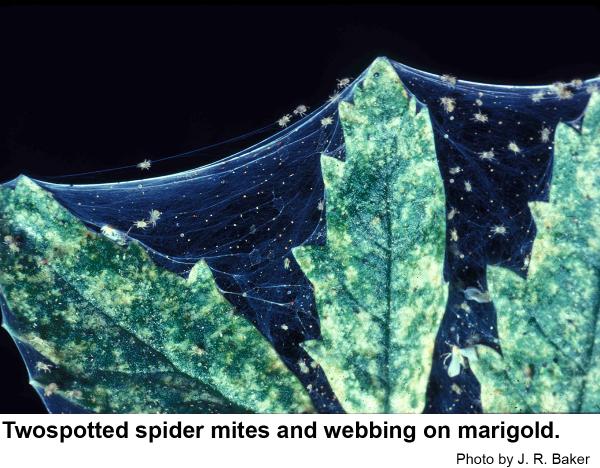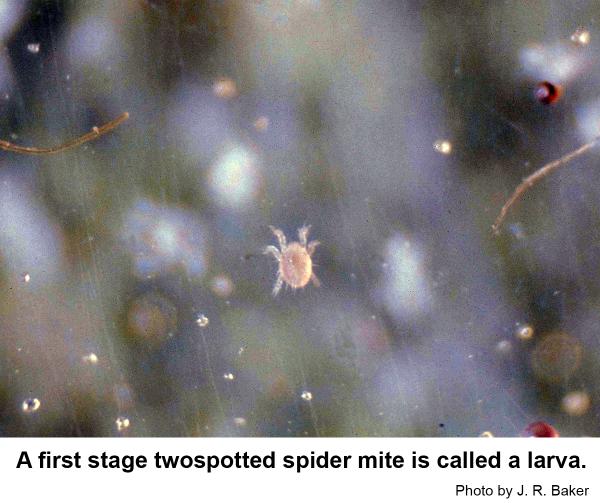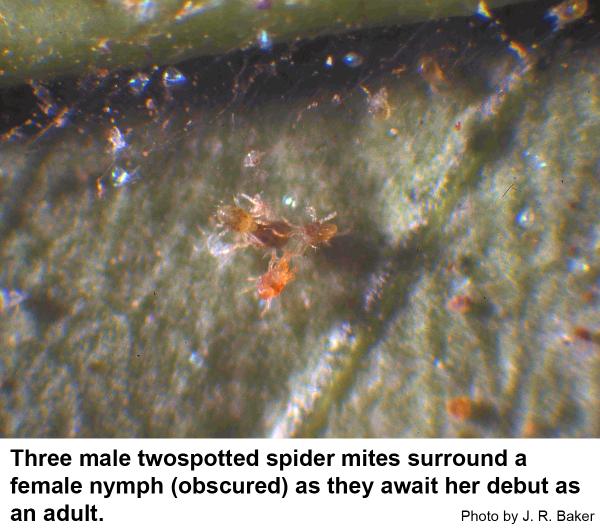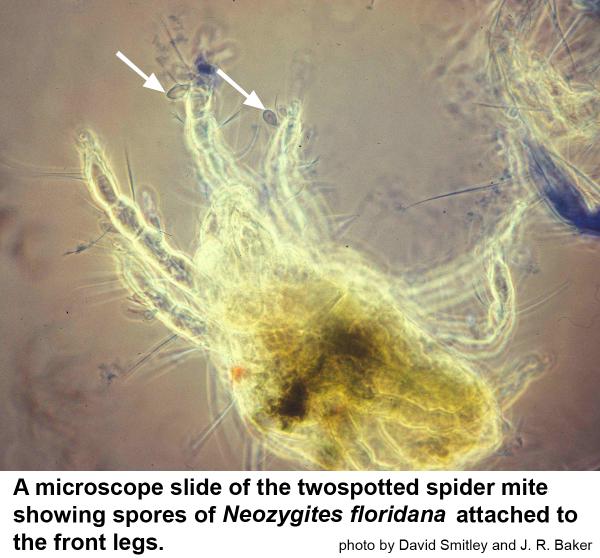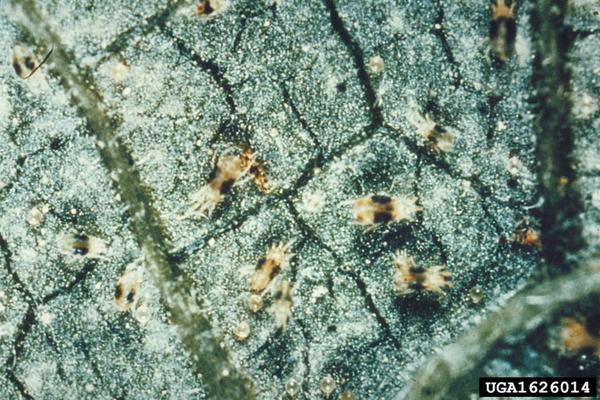Description and Biology
Twospotted spider mites, Tetranychus urticae, are tiny, oval,eight legged creatures about 0.4mm long. They characteristically have two (sometimes four) dark spots on the back. They are typically yellow or greenish amber but, overwintering females are red to orange. Twospotted spider mite nymphs are smaller and can be brownish-green but otherwise resemble adults. Eggs are colorless or white spheres usually found on the leaf’s underside. Eggs are usually covered by fine silk webbing and they hatch in about three days. A twospotted spider mite female can lay up to one hundred eggs in her lifetime. Newly hatched larvae have only six legs, but nymphs have eight legs. In summer, twospotted spider mites develop in as few days as five. In cooler weather, it may take three weeks to develop from newly laid egg to larva to protonymph to deutonymph and finally to adult. We have many overlapping generations in North Carolina. Females live two to four weeks and lay several hundred eggs each.
Biology in Strawberries
Spider mites are the most common, and often the most severe, arthropod pest of North Carolina strawberries. Several species of spider mites may feed on strawberries, including carmine mites and strawberry spider mites, but twospotted spider mites are the most common. Adult twospotted spider mites (Tetranychus urticae) are small (about 0.4mm long) and round with eight legs. Their common name comes from the two to four dark spots on their back, which develop after mites begin to feed. Twospotted spider mites are typically yellow-green or amber in color, but overwintering, non-reproducing, females are red or orange. Eggs are translucent white and are laid on the underside of leaves. Newly hatched spider mite larvae have six legs (Washington State University has posted nice larval images), but after their first molt, their full compliment of eight legs are present. Twospotted spider mite nymphs are smaller and can be brownish-green but otherwise appear similar to adult counterparts. A twospotted spider mite female can lay up to one hundred eggs during her one to two-week lifetime.
Damage in Strawberry
Twospotted spider mites feed on plant cell contents using their piercing-sucking mouthparts, and over 100 plant species have been reported as hosts. Spider mites are most commonly found on undersides of leaves and, as their name suggests, produce webbing. Webbing may be observed before mites on severely infested plants.
Low densities of spider mites, less than 5 per leaflet, can reduce strawberry yields if they feed on plants early in the year, but they do not produce easily observed damage. Scouting in the early spring is very important for detecting these populations and preventing yield loss. In North Carolina, strawberry plants can tolerate higher populations of spider mites once harvest has begun. In that case, larger populations of spider mites, greater than 20 per leaflet, can cause leaves to bronze or yellow. Heavily infested leaves will feel brittle and may be covered with webbing.
Sampling
Growers should carefully observe transplants for spider mites before planting and should determine what, if any, miticides were used in the greenhouse during plant production for resistance management. If spider mites are present on transplants, they can be treated either before or after transplant. If miticides are used before transplant, growers must be careful to use appropriate personal protective equipment if plants are handled before the re entry interval.
If row covers are to be used, strawberry plants should be sampled before for spider mites before they are placed.
Starting in early spring, late February or early March in North Carolina, growers should sample for twospotted spider mites weekly by collecting 10 leaflets (one of the three leaf sections) per acre. They should then count the number of mobile mites per leaflet, which can be done using a hand lens (at least 10x magnification) or another magnifier. We've developed a video that demonstrates spider mite sampling.
The current recommended threshold for early spring infestations of spider mites, adapted from work conducted in California, is 5 or more mobile mites per leaflet. As plants begin to fruit, however, higher mite populations can be tolerated. If mites are managed properly in the early spring, it is rarely necessary to treat during harvest. If large mite populations, greater than 20 per leaflet, are observed during fruiting, management action can be taken, but these efforts will not necessarily improve yield.
Management Options
Conventional miticides
There are several miticides labeled for use in strawberries. Twospotted spider mites reproduce very quickly and have the potential to rapidly develop resistance to chemical controls. Therefore, it is essential to rotate between miticide mode of action if more than one application is needed. Refer to the North Carolina Agricultural Chemicals Manual for materials recommended for use against twospotted spider mites in North Carolina and the Southern Region Small Fruit Consortium Strawberry IPM Guide for regional recommendations.
Organic miticides
Some horticultural oils and soaps have been demonstrated to reduce twospotted spider mite densities in the short term. Refer to the North Carolina Agricultural Chemicals Manual for materials recommended for use against twospotted spider mites in North Carolina and the Southern Region Small Fruit Consortium Strawberry IPM Guide for regional recommendations.
Biological control
Several predatory mites are commercially available for use against twospotted and other spider mites. Follow supplier recommendations for release rates and timings. A southeastern native, mite-pathogenic fungus, Neozygites floridana, can also significantly reduce twospotted spider mite populations in the southeast, particularly under damp or rainy conditions. N. floridana may be negatively impacted by some fungicides, and unnecessary fungicide treatments should be avoided.
Twospotted Spider Mites in Ornamentals
Twospotted spider mites are widely distributed in the United States and feed on over 180 host plants, including over 100 cultivated species. Violets, chickweed, pokeweed, wild mustard and blackberry are common sources from which mites spread to nearby plants. Twospotted spider mites pierce the epidermis of the host plant leaf with their sharp, slender mouthparts. When they extract the sap, the mesophyll tissue of the leaf collapses in the area of the puncture. Soon a pale spot forms at each puncture. After a heavy attack, an entire plant may become yellowed, bronzed or killed completely. The mites may spin so much webbing over the plant that it becomes entirely covered.
Residential Recommendation
Strawberries
Strawberry cultivars vary in mite infestation susceptibility, however, plants with low vigor often be more susceptible. Vigor can be increased by using polyethylene mulch, preparing the soil and proper irrigation. It is imperative not only that the plants are being watered properly but also that proper mulching conserves the moisture. In other words, take care that your plants are healthy and strong and you won’t need to be too concerned with mite infestations.
Another option would be different types of miticides. Insecticidal soap and various oils are available for use in a home garden setting. These methods of defense are low impact and would not harm humans or any non-targets. The only downside is that multiple applications would mostly likely be required as the soap and oils only kill mites that come into contact with the product. There are no residual affects. There are some organically accepted methods of management including rosemary oil spray, stylet oil spray or even use of predatory mites.
Ornamentals
Soaps, horticultural oils, and bifenthrin are all available for home use. Soaps and oils have little residual activity once the residue has dried. Bifenthrin, a pyrethroid, has up to two weeks of residual activity but it is harsh on beneficial insects such as lady beetles, lacewings, big-eyed bugs, six spotted thrips, and other predators of spider mites. When used as directed, pyrethroids are very toxic to insects but are not particularly hazardous to humans and pets (other than fish-avoid using pyrethroids around pools, ponds, and streams). Be sure to follow the directions for safe use found on the label of whichever pesticide is used.
More information
- Common name: twospotted spider mite, scientific name: Tetranychus urticae Koch (Arachnida: Acari: Tetranychidae). Fasulo, T. R. and H.A. Denmark. 2000 (rev. 2009). Entomology & Nematology, FDACS/DPI, EDIS Pub. Number: EENY-150.
- Insect and Related Pests of Flowers and Foliage Plants. Baker, J. R. ed. 1994 (revised). NC Coop. Ext. Service publication AG-136.
- Insect and Related Pests of Shrubs. Baker, J. R. ed. 1980. NC Agricultural Extension Service publication AG-189. 199 pp.
- Meet the predators – NC Small Fruit & Specialty Crop IPM
- Mode of Action Database – Insecticide Resistance Action Committee
- North Carolina Agricultural Chemicals Manual
- Role of the entomophagous fungus Neozygites floridana in population declines of the twospotted spider mite, Tetranychus urticae, on field corn. - D.R. Smitley and G.G. Kennedy in Entomologia Experimentalis et Applicata
- Spider Mites. Cranshaw, W. S. and D. C. Sclar. 2014. Insect Series, Home and Garden Fact Sheet No. 5.507.
- Spider mites in strawberry – UC IPM Online
- Strawberry IPM Guide – Southern Region Small Fruit Consortium
- Twospotted spider mite – Insecticide Resistance Action Committee
- Twospotted Spider Mites on Landscape Plants. Frank, S. D. 2009. Entomology Insect Notes, NC State Extension Publications.
- Twospotted spider mite – Washington State University Orchard Pest Management Online
- Using a mite brush to sample twospotted spider mites - NC Small Fruit & Specialty Crop IPM YouTube Channel
- Extension Plant Pathology Publications and Factsheets
- Horticultural Science Publications
For assistance with a specific problem, contact your local N.C. Cooperative Extension Center
Publication date: Oct. 23, 2013
Recommendations for the use of agricultural chemicals are included in this publication as a convenience to the reader. The use of brand names and any mention or listing of commercial products or services in this publication does not imply endorsement by NC State University or N.C. A&T State University nor discrimination against similar products or services not mentioned. Individuals who use agricultural chemicals are responsible for ensuring that the intended use complies with current regulations and conforms to the product label. Be sure to obtain current information about usage regulations and examine a current product label before applying any chemical. For assistance, contact your local N.C. Cooperative Extension county center.
N.C. Cooperative Extension prohibits discrimination and harassment regardless of age, color, disability, family and marital status, gender identity, national origin, political beliefs, race, religion, sex (including pregnancy), sexual orientation and veteran status.

